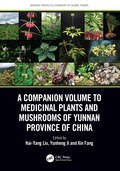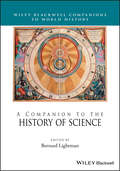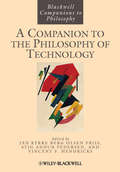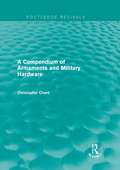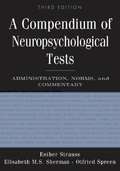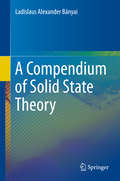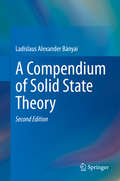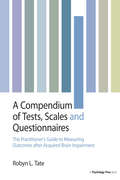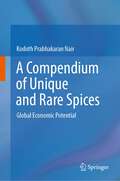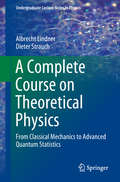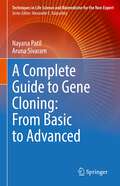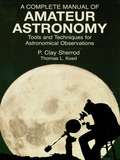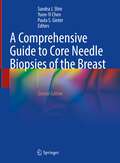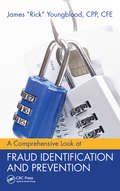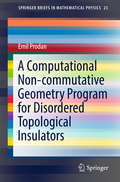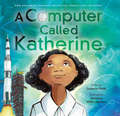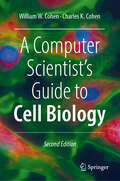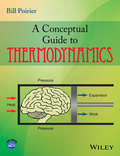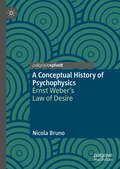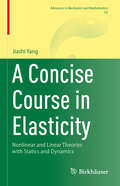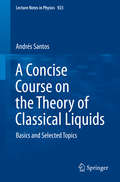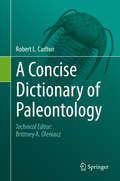- Table View
- List View
A Companion Volume to Medicinal Plants and Mushrooms of Yunnan Province of China (Natural Products Chemistry of Global Plants)
by Yunheng Ji Hai-Yang Liu Xin FangThe old saying “no prescription can be made without Yunnan medicinal materials” suggests the profound heritage and extensive influence of Yunnan's ethnic medicine culture and medicinal plant resources. This book, A Companion Volume to Medicinal Plants and Mushrooms of Yunnan Province of China, continues the systematical introduction of the plant morphological characteristics, medicinal history, resource situation, traditional uses, ethnopharmacology, phytochemicals, pharmacological effects, biosynthesis, and sustainable utilization of some important or endemic medicinal plants and mushrooms of Yunnan Province of China, including Amomi Fructus, Amomum tsaoko, Angelica sinensis, Aucklandia costus, Gentiana rigescens, Phyllanthus emblica, and Polygonatum kingianu, Tricholoma matsutake, etc. Furthermore, this book offers strategies and advice for sustainable utilization and rational exploitation of medicinal plant resources in Yunnan, drawing on the basis of the author's years of practice in the field. Reviews species-specific natural products discovered from Yunnan medicinal plants, and their bio-activities. Provides a brief introduction to the commercial drugs and health products developed based on these medicinal plants. Discusses the resource availability and conservation status of these medicinal plants. For those threatened species, the causes of their endangerment are summarized and conservation strategies are proposed. Enhances understanding with high-quality original photographs and illustrations of the plants, their habitats, and usage in traditional remedies.
A Companion to the History of American Science (Wiley Blackwell Companions to American History)
by Mark A. Largent Georgina M. MontgomeryA Companion to the History of American Science offers a collection of essays that give an authoritative overview of the most recent scholarship on the history of American science. Covers topics including astronomy, agriculture, chemistry, eugenics, Big Science, military technology, and more Features contributions by the most accomplished scholars in the field of science history Covers pivotal events in U.S. history that shaped the development of science and science policy such as WWII, the Cold War, and the Women’s Rights movement
A Companion to the History of Science (Wiley Blackwell Companions to World History)
by Bernard LightmanThe Wiley Blackwell Companion to the History of Science is a single volume companion that discusses the history of science as it is done today, providing a survey of the debates and issues that dominate current scholarly discussion, with contributions from leading international scholars. Provides a single-volume overview of current scholarship in the history of science edited by one of the leading figures in the field Features forty essays by leading international scholars providing an overview of the key debates and developments in the history of science Reflects the shift towards deeper historical contextualization within the field Helps communicate and integrate perspectives from the history of science with other areas of historical inquiry Includes discussion of non-Western themes which are integrated throughout the chapters Divided into four sections based on key analytic categories that reflect new approaches in the field
A Companion to the Philosophy of Technology
by Vincent F. Hendricks Jan Kyrre Olsen Stig Andur PedersenDrawing on essays from leading international and multi-disciplinary scholars, A Companion to the Philosophy of Technology is the first comprehensive and authoritative reference source to cover the key issues of technology's impact on society and our lives.Presents the first complete, authoritative reference work in the fieldOrganized thematically for use both as a full introduction to the field or an encyclopedic referenceDraws on original essays from leading interdisciplinary scholarsFeatures the most up-to-date and cutting edge research in the interdisciplinary fields of philosophy, technology, and their broader intellectual environments
A Companion to the Philosophy of Technology (Blackwell Companions to Philosophy #78)
by Vincent F. Hendricks Jan Kyrre Olsen Stig Andur PedersenDrawing on essays from leading international and multi-disciplinary scholars, A Companion to the Philosophy of Technology is the first comprehensive and authoritative reference source to cover the key issues of technology’s impact on society and our lives. Presents the first complete, authoritative reference work in the field Organized thematically for use both as a full introduction to the field or an encyclopedic reference Draws on original essays from leading interdisciplinary scholars Features the most up-to-date and cutting edge research in the interdisciplinary fields of philosophy, technology, and their broader intellectual environments
A Compendium of Armaments and Military Hardware (Routledge Revivals)
by Christopher ChantFirst published in 1987, The Compendium of Armaments and Military Hardware provides, within a single volume, the salient technical and operational details of the most important weapons. The complete range of hardware used in land, sea and air forces throughout the world at the time of publication is covered, from tanks to rocket systems, helicopters to cruise missiles, alongside full details of size, weight and operational range. The book’s main strength lies in the detail it gives of armament and associated ammunition capabilities, and of the sensors and other electronics required for the weapons to be used effectively. A key title amongst Routledge reference reissues, Christopher Chant’s important work will be of great value to students and professionals requiring a comprehensive and accessible reference guide, as well as to weapons ‘buffs’.
A Compendium of Neuropsychological Tests: Administration, Norms, and Commentary
by Esther Strauss Elisabeth M. S. Sherman Otfried SpreenFor the practicing neuropsychologist or researcher, keeping up with the sheer number of newly published or updated tests is a challenge, as is evaluating the utility and psychometric properties of neuropsychological tests in a clinical context. The goal of the third edition of A Compendium of Neuropsychological Tests, a well-established neuropsychology reference text, is twofold. First, the Compendium is intended to serve as a guidebook that provides a comprehensive overview of the essential aspects of neuropsychological assessment practice. Second, it is intended as a comprehensive sourcebook of critical reviews of major neuropsychological assessment tools for the use by practicing clinicians and researchers. Written in a comprehensive, easy-to-read reference format, and based on exhaustive review of research literature in neuropsychology, neurology, psychology, and related disciplines, the book covers topics such as basic aspects of neuropsychological assessment as well as the theoretical background, norms, and the utility, reliability, and validity of neuropsychological tests. For this third edition, all chapters have been extensively revised and updated. The text has been considerably expanded to provide a comprehensive yet practical overview of the state of the field. Two new chapters have been added: "Psychometrics in Neuropsychological Assessment" and "Norms in Psychological Assessment. " The first two chapters present basic psychometric concepts and principles. Chapters three and four consider practical aspects of the history-taking interview and the assessment process itself. Chapter five provides guidelines on report-writing and chapters six through sixteen consist of detailed, critical reviews of neuropsychological tests, and address the topics of intelligence, achievement, executive function, attention, memory, language, visual perception, somatosensory olfactory function, mood/personality, and response bias. A unique feature is the inclusion of tables that summarize salient features of tests within each domain so that readers can easily compare measures. Additional tables within each test review summarize important features of each test, highlight aspects of each normative dataset, and provide an overview of psychometric properties. Of interest to neuropsychologists, neurologists, psychiatrists, and educational and clinical psychologists working with adults as well as pediatric populations, this volume will aid practitioners in selecting appropriate testing measures for their patients, and will provide them with the knowledge needed to make empirically supported interpretations of test results.
A Compendium of Solid State Theory
by Ladislaus Alexander BányaiDesigned to sit alongside more conventional established condensed matter physics textbooks, this compact volume offers a concise presentation of the principles of solid state theory, ideal for advanced students and researchers requiring an overview or a quick refresher on a specific topic.The book starts from the one-electron theory of solid state physics, moving through electron-electron interaction and many-body approximation schemes, to lattice oscillations and their interactions with electrons. Subsequent chapters discuss transport theory and optical properties, phase transitions and some properties of low-dimensional semiconductors. Throughout the text, mathematical proofs are often only sketched, and the final chapter of the book reviews some of the key concepts and formulae used in theoretical physics.Aimed primarily at graduate and advanced undergraduate students taking courses on condensed matter theory, the book serves as a study guide to reinforce concepts learned through conventional solid state texts. Researchers and lecturers will also find it a useful resource as a concise set of notes on fundamental topics.
A Compendium of Solid State Theory
by Ladislaus Alexander BányaiDesigned to sit alongside more conventional established condensed matter physics textbooks, this compact volume offers a concise presentation of the principles of solid state theory, ideal for advanced students and researchers requiring an overview or a quick refresher on a specific topic.The book starts from the one-electron theory of solid state physics, moving through electron-electron interaction and many-body approximation schemes, to lattice oscillations and their interactions with electrons. Subsequent chapters discuss transport theory and optical properties, phase transitions and some properties of low-dimensional semiconductors. This extensively expanded second edition includes new material on adiabatic perturbation theory, kinetic coefficients, the Nyquist theorem, Bose condensation, and the field-theoretical approach to non-relativistic quantum electrodynamics. Throughout the text, mathematical proofs are often only sketched, and the final chapter of the book reviews some of the key concepts and formulae used in theoretical physics.Aimed primarily at graduate and advanced undergraduate students taking courses on condensed matter theory, the book serves as a study guide to reinforce concepts learned through conventional solid state texts. Researchers and lecturers will also find it a useful resource as a concise set of notes on fundamental topics.
A Compendium of Tests, Scales and Questionnaires: The Practitioner's Guide to Measuring Outcomes after Acquired Brain Impairment
by Robyn L. TateThis Compendium is a comprehensive reference manual containing an extensive selection of instruments developed to measure signs and symptoms commonly encountered in neurological conditions, both progressive and non-progressive. It provides a repository of established instruments, as well as newly-developed scales, and covers all aspects of the functional consequences of acquired brain impairment.In particular, the text provides a detailed review of approximately 150 specialist instruments for the assessment of people with neurological conditions such as dementia, multiple sclerosis, stroke and traumatic brain injury. Part A presents scales examining body functions, including consciousness and orientation; general and specific cognitive functions; regulation of behaviour, thought, and emotion; and motor-sensory functions. Part B reviews scales of daily living activities and community participation. Part C focuses on contextual factors, specifically environmental issues, and Part D contains multidimensional and quality of life instruments.Each instrument is described in a stand-alone report using a uniform format. A brief history of the instrument's development is provided, along with a description of item content and administration/scoring procedures. Psychometric properties are reviewed and a critical commentary is provided. Key references are cited and in most cases the actual scale is included, giving the reader easy access to the instrument. The structure of the book directly maps onto the taxonomy of the influential International Classification of Functioning, Disability and Health (World Health Organization, 2001), enabling linkage of clinical concepts across health conditions.The Compendium will be a valuable reference for clinicians, researchers, educators, and graduate students, and a practical resource for those involved in the assessment of people with brain impairment. The book is accompanied by a password protected website. For a one-off payment, purchasers of the book can gain online access to the majority of the tests, scales and questionnaires featured in the book as downloadable PDFs. See inside the book for more details.
A Compendium of Unique and Rare Spices: Global Economic Potential
by Kodoth Prabhakaran NairThis book is a compendium of rare and unique spices, which have been least researched but hold immense economic potential on a global scale. They are Aniseed, Shallot, Saffron, Caraway or Siah Zira, European or Indian Dill, Poppy, Star Anise and Japanese Star Anise, Sage, Savory, Tarragon, Thyme, Calamus or Sweet Flag, Horse Radish, Galangal, and Long Pepper or Pipli. Some of these are seed spices and others, like Saffron, are grown in the hills of Jammu and Srinagar, India and have varied uses, ranging from being very popular food flavorants to being used for religious purposes. Even within India, the country of the origin for most of the spices listed, many Indians are simply unaware of their immense economic potential. This is also the case with other countries, like Iran, where some spices, like Saffron, is widely used as a food flavorant. The book aims to be a unique compendium of these rare and unique spices to primarily enable researchers to tap into their great economic potential and, on a wider scale, help developmental agencies to tap into their immense potential in global spice trade. The book provides a cross-sectoral multi-scale assessment of developmental possibilities, globally, for rare and unique spices of immense economic importance.
A Complete Course on Theoretical Physics: From Classical Mechanics to Advanced Quantum Statistics (Undergraduate Lecture Notes in Physics)
by Albrecht Lindner Dieter StrauchKompakt und verständlich führt dieses Lehrbuch in die Grundlagen der theoretischen Physik ein. Dabei werden die üblichen Themen der Grundvorlesungen Mechanik, Elektrodynamik, Relativitätstheorie, Quantenmechanik , Thermodynamik und Statistik in einem Band zusammengefasst, um den Zusammenhang zwischen den einzelnen Teilgebieten besonders zu betonen. Ein Kapitel mit mathematischen Grundlagen der Physik erleichtert den Einstieg. Zahlreiche Übungsaufgaben dienen der Vertiefung des Stoffes.
A Complete Guide to Gene Cloning: From Basic to Advanced (Techniques in Life Science and Biomedicine for the Non-Expert)
by Nayana Patil Aruna SivaramThis comprehensive guide to gene cloning provides beginning and advanced readers with the background, standard techniques, practical applications, and ethical and safety considerations in the field. A one-stop reference for students, researchers in academia and industry, and anyone interested in a thorough but accessible overview.
A Complete Manual of Amateur Astronomy: Tools and Techniques for Astronomical Observations (Dover Books on Astronomy)
by P. Clay Sherrod Thomas L. KoedConcise, highly readable book discusses the selection, set-up, and maintenance of a telescope; amateur studies of the sun; lunar topography and occultations; and more. 124 figures. 26 halftones. 37 tables.
A Comprehensive Guide to Core Needle Biopsies of the Breast
by Sandra J. Shin Yunn-Yi Chen Paula S. GinterBreast cancer remains the leading cause of cancer in women, which makes accurate diagnoses on core needle biopsy (CNB) specimens of vital importance in staging and guiding therapy decisions for patients. The first edition of this multi-authored text written by leaders in the field from major academic medical centers provided a comprehensive guide on diagnostic breast pathology in the core biopsy setting. In addition to in-depth coverage of benign and malignant entities encountered in breast core biopsies, the book provided additional resources to improve diagnostic accuracy such as pattern-based approaches to evaluation, mimickers of breast lesions arising in extra-mammary sites, and pitfalls specific to small tissue samples. In recent years, there have been several notable developments in the field of breast pathology including revisions in AJCC breast cancer staging, updated guidelines in the testing and reporting of ER, PR, and HER2, as well as implementation of immunotherapy and companion biomarker testing. In addition, several key updates were included in the most recent edition of the WHO Classification of Breast Tumours (2020). In addition to updates specific to individual breast entities, the second edition will detail updates regarding biomarker testing in the primary and metastatic setting, and incorporate newly defined entities and updated definitions of rare tumors in alignment with the WHO Classification of Breast Tumours (2020). Furthermore, this edition will address the role of CNB in companion biomarker testing for eligibility for immunotherapy in the context of advanced triple-negative breast carcinoma. Written by leaders in the field and edited by expert breast pathologists, The Second Edition of Comprehensive Guide to Core Needle Biopsies of the Breast is the definitive reference on breast core needle biopsies for practicing pathologists, pathology trainees, oncologists and clinicians of patients with breast disease.
A Comprehensive Look at Fraud Identification and Prevention
by James R. YoungbloodDesigned to educate individuals, loss prevention associates, businesses, and consultants on the many faces of fraud in today's technologically advanced society, this book presents tips, advice, and recommendations for fraud awareness, protection, and prevention. It covers employee theft, organizational fraud, consumer fraud, identity theft, Ponzi and Pyramid schemes, and cyber crime/ fraud. It also examines how some fraud typologies can overlap and co-mingle and the best ways to make an organization's or individual's financial assets a harder target for fraud and victimization.
A Computational Approach to Statistical Arguments in Ecology and Evolution
by George F. EstabrookScientists need statistics. Increasingly this is accomplished using computational approaches. Freeing readers from the constraints, mysterious formulas and sophisticated mathematics of classical statistics, this book is ideal for researchers who want to take control of their own statistical arguments. It demonstrates how to use spreadsheet macros to calculate the probability distribution predicted for any statistic by any hypothesis. This enables readers to use anything that can be calculated (or observed) from their data as a test statistic and hypothesize any probabilistic mechanism that can generate data sets similar in structure to the one observed. A wide range of natural examples drawn from ecology, evolution, anthropology, palaeontology and related fields give valuable insights into the application of the described techniques, while complete example macros and useful procedures demonstrate the methods in action and provide starting points for readers to use or modify in their own research.
A Computational Non-commutative Geometry Program for Disordered Topological Insulators (SpringerBriefs in Mathematical Physics #23)
by Emil ProdanThis work presents a computational program based on the principles of non-commutative geometry and showcases several applications to topological insulators. Noncommutative geometry has been originally proposed by Jean Bellissard as a theoretical framework for the investigation of homogeneous condensed matter systems. Recently, this approach has been successfully applied to topological insulators, where it facilitated many rigorous results concerning the stability of the topological invariants against disorder. In the first part of the book the notion of a homogeneous material is introduced and the class of disordered crystals defined together with the classification table, which conjectures all topological phases from this class. The manuscript continues with a discussion of electrons' dynamics in disordered crystals and the theory of topological invariants in the presence of strong disorder is briefly reviewed. It is shown how all this can be captured in the language of noncommutative geometry using the concept of non-commutative Brillouin torus, and a list of known formulas for various physical response functions is presented. In the second part, auxiliary algebras are introduced and a canonical finite-volume approximation of the non-commutative Brillouin torus is developed. Explicit numerical algorithms for computing generic correlation functions are discussed. In the third part upper bounds on the numerical errors are derived and it is proved that the canonical-finite volume approximation converges extremely fast to the thermodynamic limit. Convergence tests and various applications concludes the presentation. The book is intended for graduate students and researchers in numerical and mathematical physics.
A Computer Called Katherine: How Katherine Johnson Helped Put America on the Moon
by Suzanne SladeThe inspiring true story of mathematician Katherine Johnson--made famous by the award-winning film Hidden Figures--who counted and computed her way to NASA and helped put a man on the moon!Katherine knew it was wrong that African Americans didn't have the same rights as others--as wrong as 5+5=12. She knew it was wrong that people thought women could only be teachers or nurses--as wrong as 10-5=3. And she proved everyone wrong by zooming ahead of her classmates, starting college at fifteen, and eventually joining NASA, where her calculations helped pioneer America's first manned flight into space, its first manned orbit of Earth, and the world's first trip to the moon!Award-winning author Suzanne Slade and debut artist Veronica Miller Jamison tell the story of a NASA "computer" in this smartly written, charmingly illustrated biography.
A Computer Scientist's Guide to Cell Biology
by William W. Cohen Charles K. CohenUnlike the structured world of computer science, biology is complex, evolving, and often lacks clean abstract models. This book aims to serve as a guide for computer scientists who need to understand cell biology, breaking the field into three parts: biological mechanics, experimental methods, and language/nomenclature. While biological mechanics, which investigates cellular-level details, is covered by many texts, this book also focuses on experimental methods – how biologists conduct experiments and gather data - and on helping the reader understand the language and terminology of biology, which is rich but challenging for non-biologists. A Computer Scientist's Guide to Cell Biology uses a metaphor of biology as a strange land with an unfamiliar language and customs. The goal of the book is to provide a high-level introduction to cell biology, simplifying concepts and relating them to familiar ideas from computer science, so that working computer scientists can more effectively understand read recent research papers and results.This Second Edition contains a number of updates, including discussions of CRISPR, advances in DNA Sequencing, and mRNA vaccines. It serves as an easy-to-read travel guide for computer scientists navigating the intricate and sometimes perplexing terrain of cell biology, offering insights into experimental methods and helping bridge the gap between the structured world of computer science and the complexities of biological systems.
A Conceptual Guide to Thermodynamics
by Bill PoirierThermodynamics is the science that describes the behavior of matter at the macroscopic scale, and how this arises from individual molecules. As such, it is a subject of profound practical and fundamental importance to many science and engineering fields. Despite extremely varied applications ranging from nanomotors to cosmology, the core concepts of thermodynamics such as equilibrium and entropy are the same across all disciplines. A Conceptual Guide to Thermodynamics serves as a concise, conceptual and practical supplement to the major thermodynamics textbooks used in various fields. Presenting clear explanations of the core concepts, the book aims to improve fundamental understanding of the material, as well as homework and exam performance. Distinctive features include:Terminology and Notation Key: A universal translator that addresses the myriad of conventions, terminologies, and notations found across the major thermodynamics texts.Content Maps: Specific references to each major thermodynamic text by section and page number for each new concept that is introduced.Helpful Hints and Don't Try Its: Numerous useful tips for solving problems, as well as warnings of common student pitfalls.Unique Explanations: Conceptually clear, mathematically fairly simple, yet also sufficiently precise and rigorous. A more extensive set of reference materials, including older and newer editions of the major textbooks, as well as a number of less commonly used titles, is available online at http://www.conceptualthermo.com. Undergraduate and graduate students of chemistry, physics, engineering, geosciences and biological sciences will benefit from this book, as will students preparing for graduate school entrance exams and MCATs.
A Conceptual History of Psychophysics: Ernst Weber’s Law of Desire
by Nicola BrunoThis book explores the concept of psychophysics and details the development of the ideas which made the mathematisation of desire possible. The experience of desire accompanies us all throughout life, but dealing with it as psychologists and scientists is far from easy. Psychophysics was conceived to help map, mathematically, these unknowable feelings of desire. As such, this book will help to provide an accessible account of psychophysics while telling the story of its creation, which was, in essence, the birth of scientific psychology and contemporary cognitive neuroscience, alongside many of the technologies which characterize the contemporary world. It is a strange and intriguing story, which begins with the German physiologist Ernst Heinrich Weber in the first half of the nineteenth century, and its story will help the reader gain fresh insight into how scientists came to be able to map and quantify complex and private emotional states.
A Concise Course in Elasticity: Nonlinear and Linear Theories with Statics and Dynamics (Advances in Mechanics and Mathematics #54)
by Jiashi YangThis textbook presents a concise and comprehensive treatment of the theory of elasticity. It covers both the linear and nonlinear aspects of the theory, including both statics and dynamics. Written to be accessible to the graduate student reader, this text promotes approachability by minimizing the use of complex mathematical tools, and instead emphasizing the formulation of the initial boundary value problems. This approach makes it an ideal resource for students as well as instructors seeking a textbook designed for a one-semester graduate course in elasticity. Divided into ten chapters, the book begins with a brief review of the mechanics of materials. The theory of Cartesian tensors is then introduced, which serves as a mathematical preparation for the concise treatment of the nonlinear theory of elasticity that follows. The theory of linear elasticity is covered next with the remainder of the book then focusing on problem solving in linear elasticity. These chapters cover topics such as antiplane problems, plane-stress and plane-strain problems, and elastodynamics. Five appendices appear at the end, which include basic equations of elasticity in cylindrical, polar, and spherical coordinates, as well as a collection of vector identities that appear throughout the book. A Concise Course in Elasticity is an ideal textbook for a one-semester graduate course on elasticity. Graduate students interested in this topic will appreciate the author’s accessible approach. Instructors will find the comprehensive coverage uniquely suited to providing an overview of the area. Readers are assumed to have some experience at the undergraduate level of the mechanics of materials.
A Concise Course on the Theory of Classical Liquids: Basics and Selected Topics (Lecture Notes in Physics #923)
by Andrés SantosThis short primer offers non-specialist readers a concise, yetcomprehensive introduction to the field of classical fluids - providing bothfundamental information and a number of selected topics to bridge the gapbetween the basics and ongoing research. In particular, hard-sphere systems represent a favorite playground instatistical mechanics, both in and out of equilibrium, as they represent thesimplest models of many-body systems of interacting particles, and at highertemperature and densities they have proven to be very useful as referencesystems for real fluids. Moreover, their usefulness in the realm of softcondensed matter has become increasingly recognized - for instance, theeffective interaction among (sterically stabilized) colloidal particles can betuned to almost perfectly match the hard-sphere model. These lecture notes present a brief, self-contained overview ofequilibrium statistical mechanics of classical fluids, with specialapplications to both the structural and thermodynamic properties of systemsmade of particles interacting via the hard-sphere potential or closely relatedmodel potentials. In particular it addresses the exact statistical-mechanicalproperties of one-dimensional systems, the issue of thermodynamic(in)consistency among different routes in the context of several approximatetheories, and the construction of analytical or semi-analytical approximationsfor the structural properties. Written pedagogically at the graduate level, with many figures, tables,photographs, and guided end-of-chapter exercises, this introductory textbenefits students and newcomers to the field alike.
A Concise Dictionary of Paleontology
by Robert L. CarltonThis authored dictionary presents a unique glossary of paleontological terms, taxa, localities, and concepts, with focus on the most significant orders, genera, and species in terms of historical turning points such as mass extinctions. The book is an accurate and up-to-date collection of the most important paleontological terms and taxa, and may be used as a resource by students, researchers, libraries, and museums.Though useful to many in professional and academic settings, the book is also aimed at general readers of scientific literature who may enjoy the material without a background in paleontology. While there are many current resources on the subject, few fully encapsulate an accurate representation of the paleontological lexicon. This book attempts to compile such a representation in a moderately comprehensive manner, and includes a list of the most important monographs and articles that have been consulted to put together this essential work.
